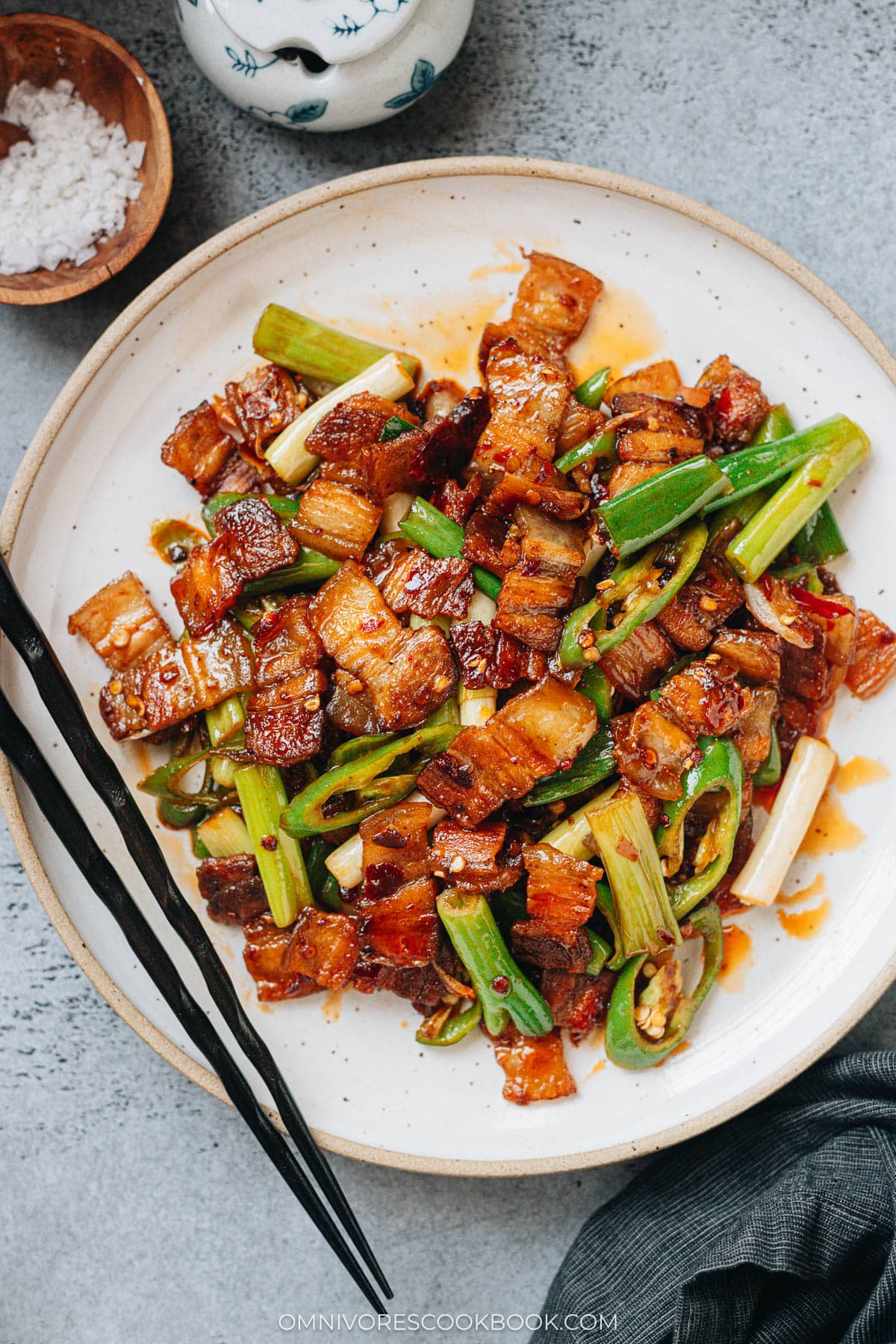
Twice cooked pork has always been special to me because it represents everything I love about Sichuan cooking: thoughtful technique, bold yet balanced flavors, and incredible depth from just a handful of ingredients. The two-step method creates a pork belly dish that is rich yet not greasy. Just like the classic mapo tofu, the combo of Doubanjiang, Sichuan peppercorn, Shaoxing wine and scallion perfectly showcases how Sichuan cuisine builds complexity through layering. Every time I make this dish, I’m reminded of how beautifully Sichuan cooking transforms simple ingredients into something bold and multidimensional.
What is twice cooked pork
Twice cooked pork (回锅肉) is one of the most iconic dishes from Sichuan cuisine. The name comes from the traditional method: the pork is gently simmered first, then sliced and returned to the wok for its second cooking. The thinly sliced pork is seared until lightly crispy, and stir-fried with doubanjiang, Sichuan peppercorn, and plenty of green onion. The result is a dish that’s deeply savory, slightly spicy, and incredibly fragrant, with just the right balance of fat, heat, and umami. It’s simple enough for a weeknight, yet bold and complex enough to satisfy any Sichuan craving.
Ingredients
Twice cooked pork uses a few Sichuan pantry ingredients to create a bold yet balanced taste.
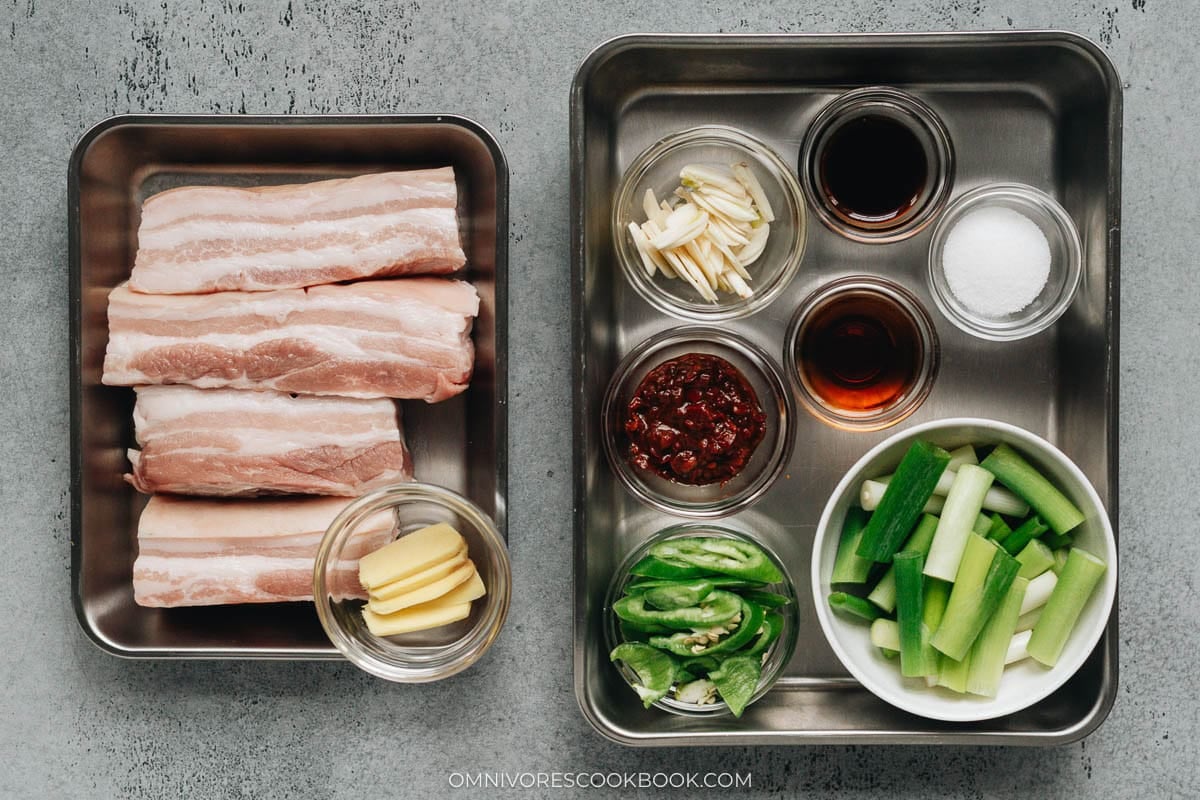
Pork belly
Chinese restaurants usually use medium fatty skin-on pork belly that has several thin fat layers. This type of pork belly creates a scrumptious texture that has a slightly chewy lean part, crispy edges, and tender fat layers that are not greasy.
Alternatively, you can choose leaner pork belly as well, if you prefer. The finished pork will be a little chewier, but still tasty.
Authentic pork belly dishes usually include the pork skin, and so does my recipe. But if you dislike the texture, feel free to remove it before cooking.
Aromatics
I use ginger to blanch the pork, eliminating gameness and creating a clean flavor. Garlic creates the aromatic oil that pairs well with Doubanjiang, while scallion adds a natural sweetness and texture to the final dish.
Doubanjiang – the main seasoning
Doubanjiang is the backbone of twice cooked pork and the ingredient that defines its signature flavor.This fermented broad bean and chili paste brings a deep, savory heat and a rich, earthy umami that no other ingredient can replicate. When it hits the rendered pork fat in the wok, the paste toasts and releases its red oil, blooming into something intensely aromatic. That red oil coats every slice of pork, giving the dish its glossy color and complex flavor. In this recipe, doubanjiang creates the bold, spicy, and slightly smoky taste that makes twice cooked pork so distinctive.
I like to use Pixian Red-Oil Doubanjiang, because it has a more balanced flavor and tastes less salty than the paste type.

Other seasoning ingredients
Sichuan peppercorns are used to add aroma, smokiness, and a hint of numbing tingling in the oil. I used a small amount of Shaoxing wine and light soy sauce to add more savory flavor and create dimension. Sugar is used to counterbalance the saltiness of the Doubanjiang, bringing out the flavor of the ingredients.
Vegetable options
In traditional Chinese cooking, chefs usually use a very small amount of chili pepper to add heat and color to the dish. In my recipe, I chose to use long green hot pepper for some heat and a crisp texture. If you prefer a less spicy dish, consider using a red bell pepper, anaheim pepper, or cubanelle pepper.
Other popular vegetables for twice cooked pork are garlic scape and garlic chive. Both have a bold flavor that fits right into the profile of the dish.
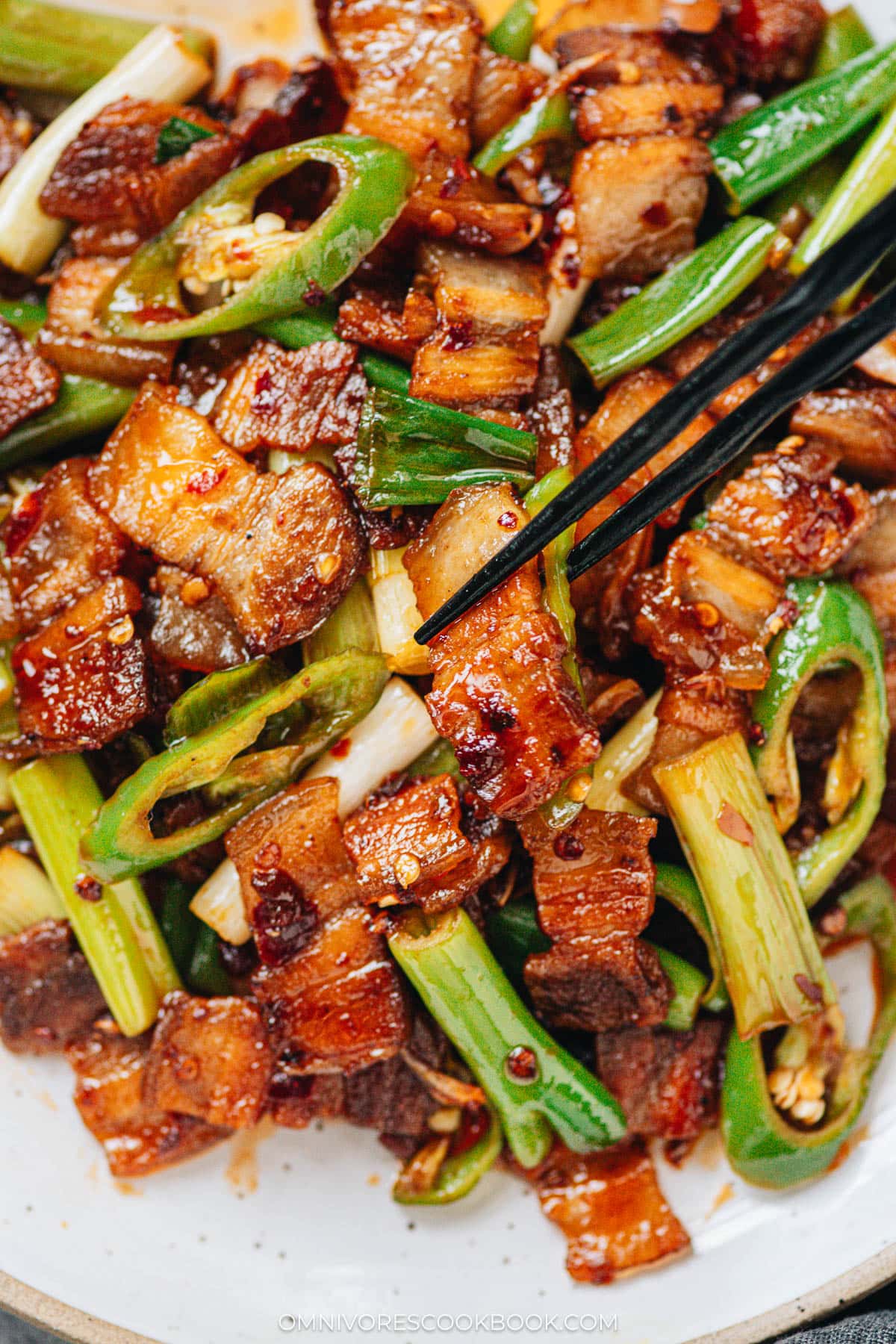
How to make
1. Boil the pork. Cut the pork into pieces that fit into your pot, add ginger and braise for 30 minutes. How you cut the pork depends on the piece of pork belly you buy. If you get a large square piece, you’ll want to slice it into long pieces that are about 1.5” (4 cm) thick. So you can further slice it into even bite-size pieces after braising. If your pork belly is quite long, you might need to cut it to 2 to 3 pieces crosswise to fit into your pot. The braising will cook through the pork, get rid of impurities, and render some fat. It also creates tender pork that’s ready for stir frying.
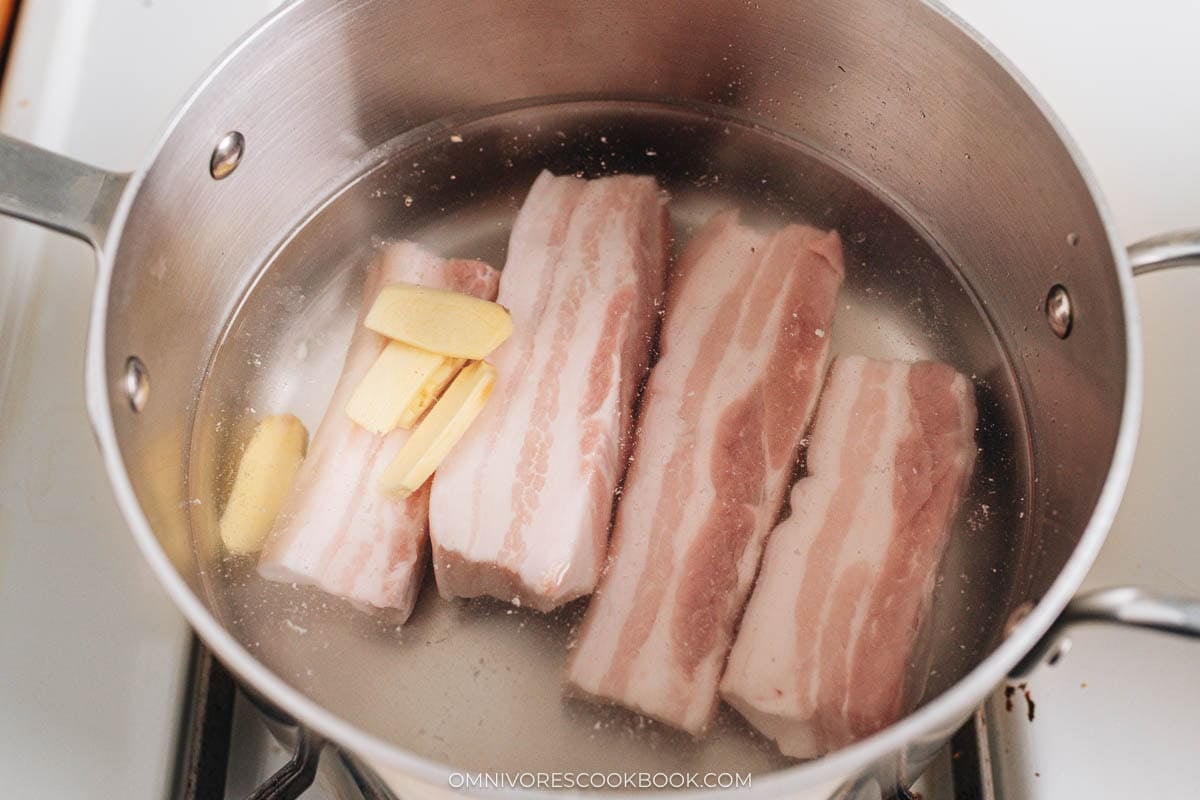
2. Dry the pork thoroughly. This is a key step that’s easily overlooked. When cooked in hot oil, pork belly can easily cause splatter because of its high moisture content combined with its high fat content. You should dry the pork belly as much as you can to prevent splattering.
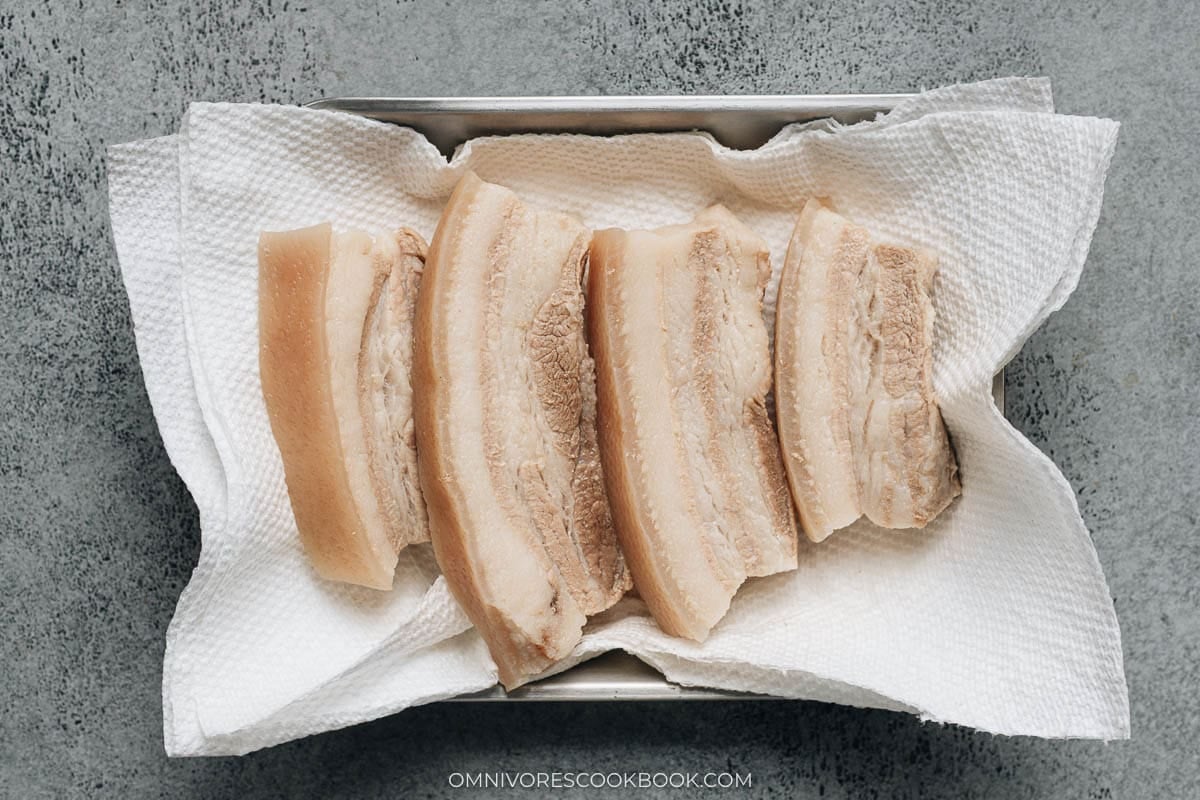
3. Slice the pork belly. I like to cut the pork belly into 1/8” (3-mm) thick pieces. If you cut them too thin, they dry out fast and turn dry. If cut too thick, the fat won’t be rendered properly and the dish will taste greasy.
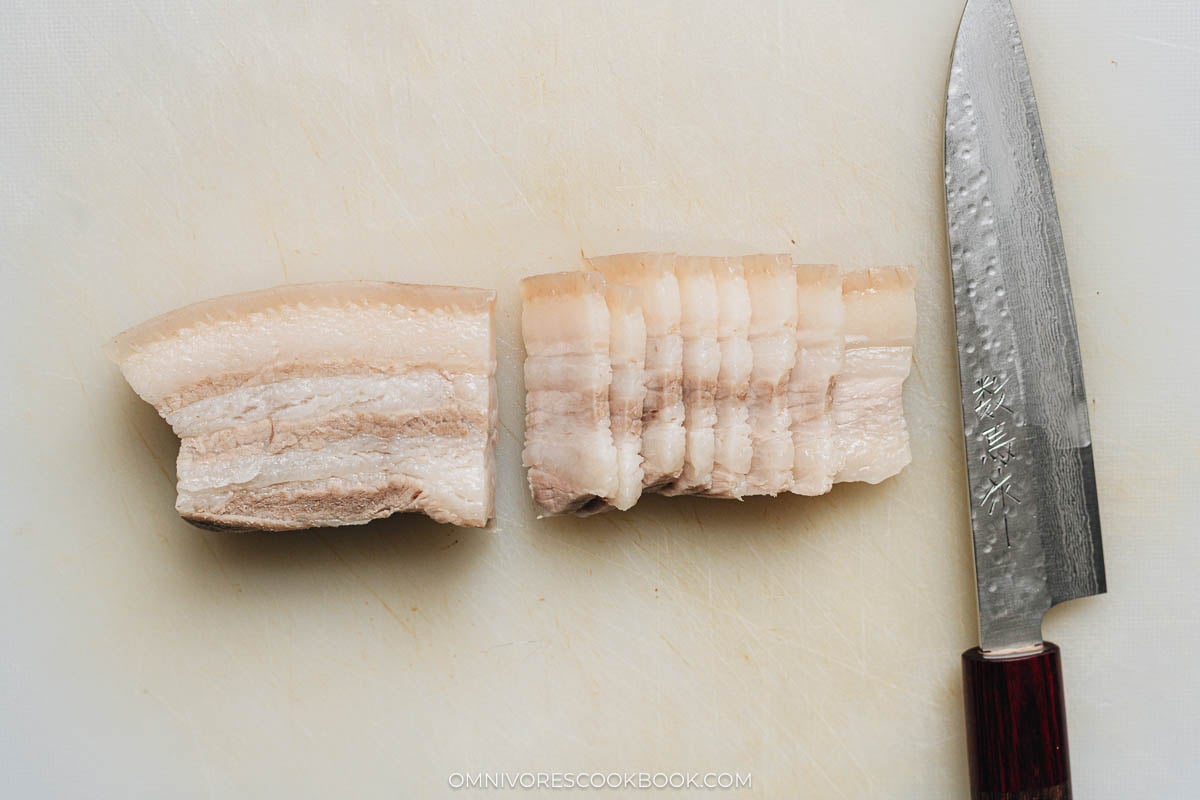
4. Cook the pork belly. This step renders more fat from the pork belly and creates a crispy texture. Note, The first few minutes are the danger zone and there will be some splatter. Because the pork belly is releasing both steam and rendered fat at the same time. You can minimize it by not heating the wok too hot and starting at medium heat. Once enough moisture cooks off, the splatter will naturally subside and the pork will begin to crisp up. But also note, you still want the pan to be hot enough, so the pork belly browns properly without turning dry.

5. Remove the rendered fat. Depending on the pork belly you use, you may need to remove quite a lot of fat. Make sure you reserve at least 1 to 2 tablespoons of fat / oil at the end, so you have enough to bloom the doubanjiang.

6. Cook doubanjiang, Sichuan peppercorn and aromatics to infuse the oil. Cook the doubanjiang thoroughly to bring out the flavor and infuse the oil, but not too much that it burns.
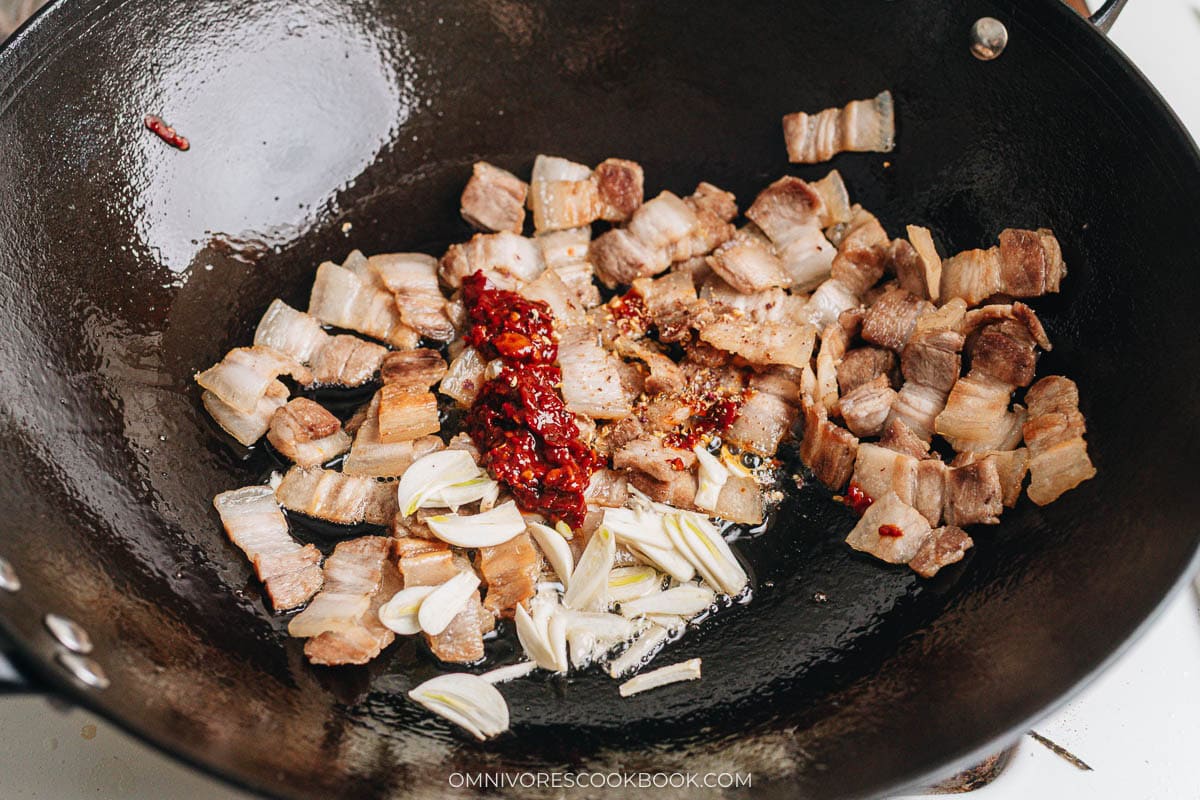
7. Cook the vegetables. Finish up by cooking the pepper, scallion, and the rest of the seasonings.
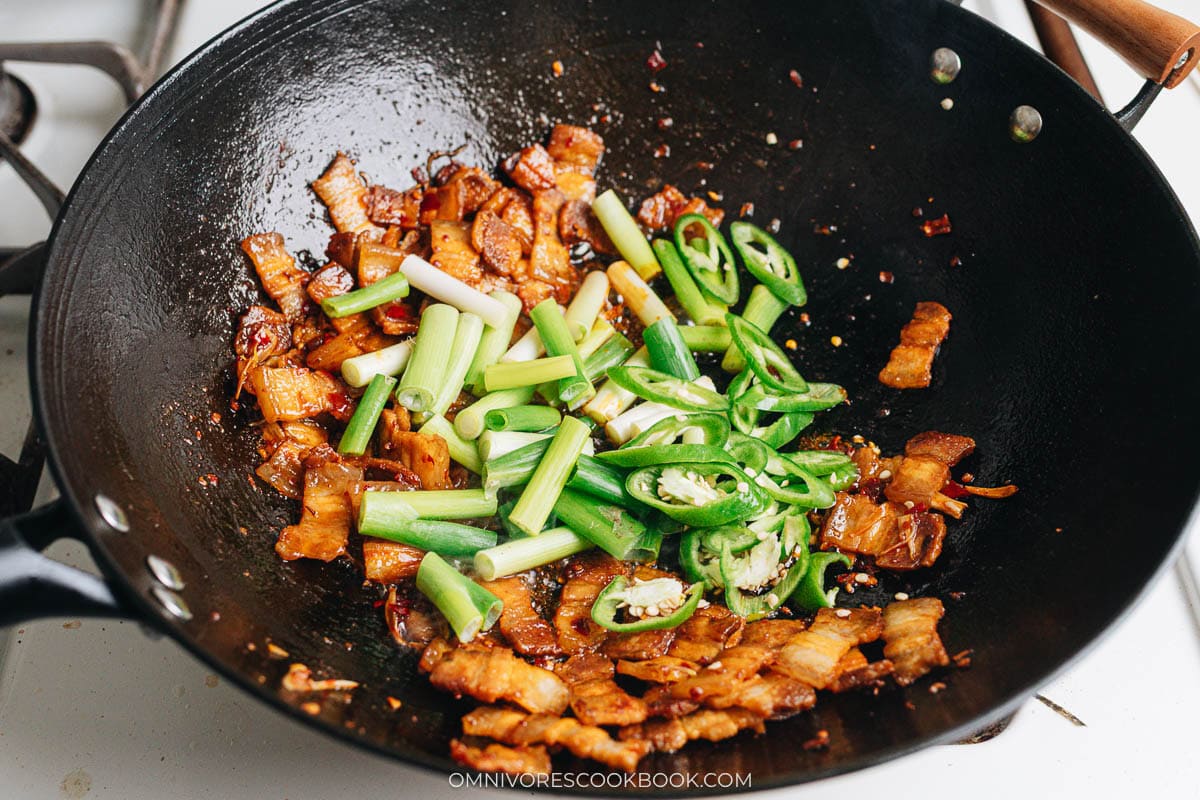
Once you’re done cooking, the pork belly will be slightly crispy on the edges and a bit chewy on the lean part. It will have a bold and spicy flavor that is very scrumptious without being too greasy. The crisp pepper and tender scallion pair so well together, both lightening up the dish and adding texture.
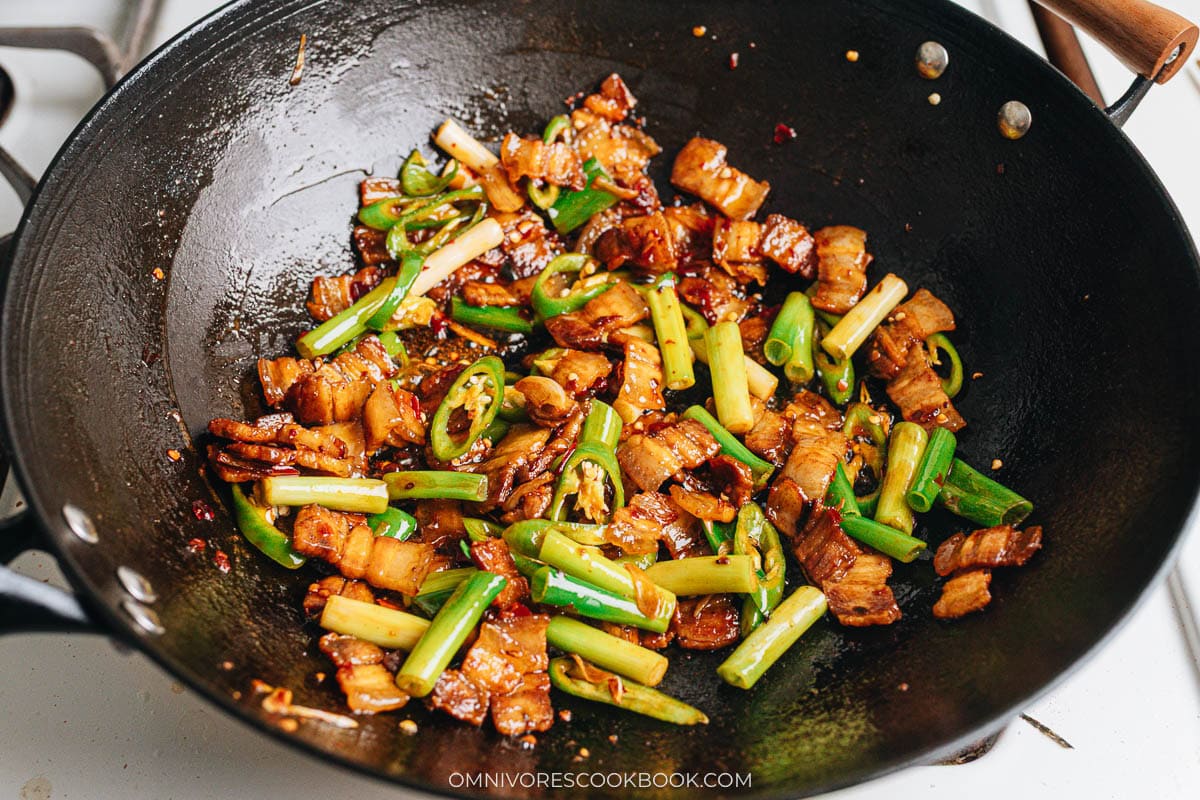
Why does it still splatter even after drying the pork belly?
Pork belly has thick layers of fat. When exposed to heat, the fat melts and releases liquid fat quickly. That melted fat interacts violently with any remaining small pockets of moisture, creating more popping.
Second, even after simmering and patting it dry, pork belly still contains a lot of internal moisture. When the slices hit the hot oil, that moisture instantly converts to steam. As the steam escapes, it pushes the hot oil outward, causing splattering.
How to serve
Twice cooked pork is a quite rich dish and I highly recommend serving it over steamed rice as a main dish. To lighten up your meal, some quick pickled cabbage and wood ear mushroom salad pair perfectly with it.
For a Sichuan themed dinner party, consider pairing main dishes such as Kung Pao shrimp and Sichuan eggplant stir fry (Yu Xiang eggplant), which have a sweet and sour profile. Make sure to add a green non-spicy side dish such as stir fried pea shoots or Sichuan dry fried green beans. So your meal will be more balanced. If you want extra spice, a bowl of Dan Dan noodle works perfectly because you can prepare it ahead of time.
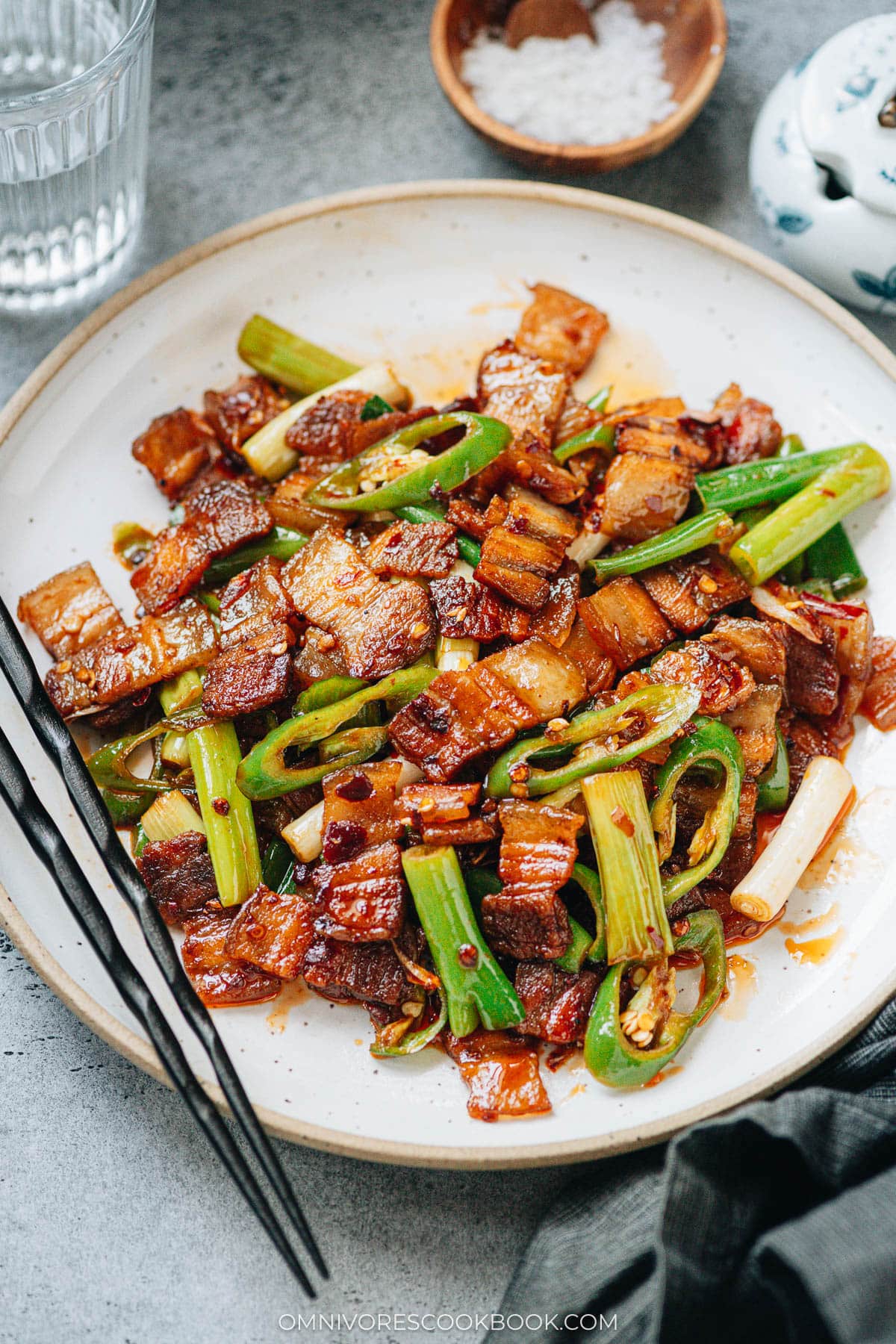
Frequently asked questions
Can I use pre-sliced pork belly?
You can. It is actually a common practice in Japanese cooking to use very thin pre-sliced pork belly to cook twice cooked pork. In this case, you’ll want to only briefly blanch the pork belly until just cooked through, 1 to 2 minutes. You will also need less time to stir fry the pork since little fat will be rendered. The dish will have a different texture but taste good nonetheless.
How do I add more vegetables to twice cooked pork?
Vegetables that work well include onion, celery (thinly sliced), and cabbage. They add a crisp texture to the dish without overpowering the seasonings. If you plan to add more vegetables, I recommend stir-frying the vegetables separately with a pinch of salt and adding them to the pork at the end. Harder vegetables such as cabbage require a longer cooking time, and you want to cook them properly without overcooking the pork.
Can I make it less spicy?
Skipping the fresh chili pepper is the easiest way. To further reduce the heat, you can also reduce the amount of doubanjiang, and replace the reduced portion with some douchi (Chinese fermented black beans) or black bean sauce.
Chinese Cooking Made Easy
Are you new to this website? This free email series is a great place to start. I’ll walk you through a few of my most popular recipes and show you how and why they work. You’ll quickly start to cook better Chinese food in your own kitchen.
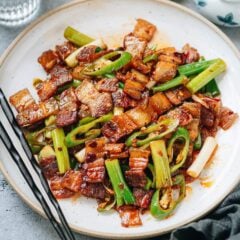
Twice Cooked Pork (回锅肉)
Ingredients
- 1 lb uncut pork belly
- 1 thumb ginger , sliced
- 1 tablespoon vegetable oil
- 2 cloves garlic
- 1 1/2 tablespoons Doubanjiang
- 1/2 teaspoon ground Sichuan peppercorn
- 1 tablespoon Shaoxing wine
- 1 teaspoon light soy sauce
- 2 teaspoons sugar
- 1 long hot pepper , sliced (or other chili pepper you prefer) (*Footnote 1)
- 4 green onions , cut into 2” (5 cm) pieces
Instructions
- Cut the pork belly crosswise into 2 to 3 pieces, so it fits your pot. Add the pork belly and ginger to a medium pot. (*Footnote 2) Add cold water to cover the pork by 1” (2.5 cm). Bring to a boil over medium-high heat. Turn to medium-low heat and simmer for 30 minutes, until the pork is just cooked through.
- Remove the pork from the pot, rinse with cold tap water to remove any impurities from the surface, and place on a plate lined with a few layers of paper towel to cool and drain the extra liquid, until you can handle it with your hands. Thoroughly pat the pork dry with paper towels and slice it into 1/8” (3-mm) thick pieces. Use more paper towels to dry the pork so it causes less splatter during the stir fry.
- Heat oil in a wok or large skillet over medium-high heat until hot but not smoking. Very carefully lower the pork belly and spread it out with no overlap. Cook, stirring frequently, until the pork turns light golden and some pieces turn golden brown.(*Footnote 3) If the pork starts to splatter too much, turn to medium heat. Use a ladle to remove most of the rendered fat, leaving about 2 tablespoons of oil in the pan. (*Footnote 4)
- Add the garlic, doubanjiang, and Sichuan peppercorn. Stir and cook until the pork is evenly coated.
- Add the pepper, green onion, Shaoxing wine, light soy sauce and sugar. Stir and cook for 1 minute, until the green onion softens. Transfer everything to a plate. Serve hot over steamed rice as a main dish.
Notes
- Use Anaheim or cubanelle pepper for a milder taste. You can also use red bell pepper as well.
- I usually keep the pork skin on since I like the texture. If you do not like pork skin, remove it before starting cooking.
- You want to render off the pork fat so the meat tastes less greasy and has a nice chewy-crispy texture. But if cooked for too long, the lean part will dry out. I found that it’s best to cook until most pieces have a light golden color, but have not turned dark golden.
- Depending on the fat content of the pork belly, you might render off a lot of fat or little fat. The pork belly I used in this recipe was well marbled and contained a good amount of fat, and I had to remove about 1/3 cup of rendered fat. If using a very lean cut of pork belly, you might not need to remove the fat.
Nutrition

Did you make this recipe?
I’d love to hear how it turned out for you! Please take a moment to leave a 5-star rating ⭐️ and share your thoughts in the comments further down the page. It really helps others discover the recipe too.

Bruce Jones
In Step 1., you mean Boil not Braise-
Maey B
This may be the best thing I have ever eaten! The pork belly is tender but a little crispy, and the Anaheim pepper added just a pleasant level of heat. Amazing dish.
John Graham
I love how you took the time to spell out how to cook this with different proteins and vegetables. This is a great recipe for matching different tastes in a family. I cook it with chicken, onions, Anaheim peppers and celery for myself. I cook the sauce with mushrooms and celery for my wife and then she adds seafood (shrimp or scallops) from the air fryer.
I also appreciate that you included your bulk sauce recipe.
Molly
My mom will not shut up about this recipe. She’s never cooked any Chinese dishes before, but she loves twice cooked pork. She had some leftover pork when I came to visit, and asked me if I had any idea how to make it. I didn’t, but I remembered coming across this website ages ago and bookmarking it, thinking the recipes all look amazing and I’d have to try some of them sometime (I think I found you on TikTok). I checked to see if you had a twice cooked pork recipe, and made sure to get the exact ingredients. I made it just like the recipe, but in addition to the pork belly, I sliced up and stir fried my moms leftover pork, and I added Anaheim peppers, like you suggested, and Napa cabbage because we love cabbage. Oh my gosh. It was so good I wanted to cry lol. It’s been two weeks and my mom keeps bringing up how amazing it was, and she just told me she got more pork belly and wants me to come make it again 😂
Thank you SO much for sharing this incredible recipe with my family. We absolutely love it, and I appreciate you so much! I’m gonna make it for my boyfriend next. We host board game nights, and we like to do hot pot at the table for everyone because it’s easy. So I love experimenting and mincing up different stuff to make into dumplings ahead of time. I’m gonna try putting this in dumpling wrappers, I bet it’ll be amazing 😂 thanks again!!! I can’t wait to try more of your amazing recipes ❤️❤️❤️
ini
When do the garlic (whole, sliced, chopped/ …?) and the ginger from the stir-fry ingredients go in?
Maggie
Just updated the recipe with the instructions. Sorry about the confusion! Some details got lost when I updated the recipe box.
Ini
👍🏻
Marijke Schellenbach
Just now in the process of downloading your stir fry sauce cookbook!!! I can’t wait to read through the whole thing and try out your recipes.
Marijke Schellenbach
What a great article and such good explanation! I will try this for sure. Thank you for always teaching us how to cook Chinese dishes. Following you faithfully.
John
Hi, Maggie. I note with interest your deviation from, dare I say it, “traditional” Twice-Cooked Pork recipe that only use scallions or leeks as the vegetable component. Many moons ago, Chinese take-out places often offered Twice-Cooked Pork with chopped green cabbage as the veggie, sometimes adding the Thai-style compressed tofu also found in Pad Thai. I really kind of liked the cabbage and, as you mentioned, the veggie helped cut the heaviness of the dish. I think I’ll try this recipe your way first, then experiment with the green cabbage. Thoughts?
Maggie
Hi John, I think the green cabbage will totally work and it will go so well with the sauce. Yeah I agree, you can follow the recipe first then experiment with different veggies and the tofu. By the way, I love the tofu idea a lot. I want to try it the next time.
If I cook the cabbage with the pork, I’d stir fry the cabbage saparately then add to the pan later. It takes much longer to cook through the cabbage. You want to make sure to the pork won’t be overcooked.
Happy cooking and hope the dish turns out great 🙂